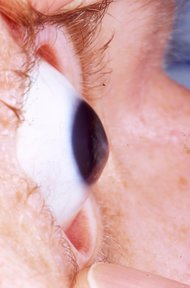Our "mystery patient" visited the Tescher Eye Center. Here's what he found.
My visit to the Tescher Eye Center in North Miami Beach, FIa., wasn't the typical courtesy call, one O.D. to another. It was my opportunity to play "mystery patient" as part of the Contact Lens Practice Upgrade, a program and evaluation co-sponsored by Optometric Management and Vistakon, division of Johnson & Johnson Vision Care Inc. For this program, several O.D. consultants and I will visit two practices, evaluate their performance in the contact lens area and recommend changes that will help each practice advance to the next level.
First up is Marc B. Tescher, O.D. Marc is following in the footsteps of his father, Edward, who started the practice in 1959.
Initial Impressions
I called the Tescher Eye Center about a week in advance to make my appointment, explaining I was new in the area and needed an eye exam. My first call was 10 minutes after the posted opening time, but I received the after-hours recording. Three minutes later, I called again and the phone was answered promptly.
The receptionist immediately asked if the appointment was for contact lenses. I was pleasantly surprised with this proactive attempt to identify my interest, which also served to make me aware that Dr. Tescher provides contact lens care. I was disappointed the person who answered the phone didn't tell me her name until I asked at the end of the call.
Cleverly disguised as Wes Walters, I made my way to Dr. Tescher's office to see how things were done from the patient's point of view.
On entering the office, I checked in at the front desk. The receptionist greeted me - but didn't introduce herself - then briefly reviewed the paperwork I needed to complete before my visit with the doctor. Although the greeting was polite and the encounter efficient, nothing gave me the feeling that anyone was particularly excited to see me.
After completing my paperwork (I did actually fill out everything), I handed it in at the front desk and was told Dr. Tescher would see me in a few minutes. After less than 10 minutes, the technician led me to the pre-test area where she performed autorefraction, tonometry and a few other tests. The only conversation was relative to where I needed to put my chin. After pre-testing was completed, the technician led me to the exam room and closed the door. I sat there wondering what her name was as she hadn't introduced herself nor was she wearing a name tag.
Dr. Tescher was expecting me, so once he entered the examination room and closed the door, we chatted about my initial observations as well as his thoughts for growing his contact lens business.
On my flight back to Nashville, I began to formulate a plan for upgrading the contact lens portion of Dr. Tescher's practice.
Areas of Opportunity
Overall, Marc Tescher's practice is doing a lot of things right and enjoys a strong flow of new as well as established patients. My recommendations will focus on converting more spectacle patients to contact lens wearers and increasing the number of new contact lens patients.
Some areas of opportunity include:
* Patient flow (physical plant). Dr. Tescher's office doesn't have enough space allocated to contact lens care. As a result, the doctors and staff often find it cumbersome to work with contact lens patients while primary care and spectacle patients are being seen. Because contact lens patients have to be moved around, they may feel they're in the way and the practice doesn't routinely provide contact lens care.
The building, which Dr. Tescher owns, has some space that can be annexed from other tenants and used for additional clinic space. Creating a "Contact Lens Center" within the office will provide a better opportunity to care for contact lens patients without clogging the primary care and spectacle patient flow.
* Patient flow (time management). The practice accepts so many discount vision plans for spectacles that contact lenses seem to be a distraction. What's more, contact lens patients are not being identified or provided for in a manner that fits in the patient flow. Developing processes specific to scheduling and patient flow will result in greater efficiency regarding the time staff and doctors spend with each patient.
* Patient allocation. As more of Dr. Marc Tescher's time is required in the Contact Lens Center, Dr. Edward Tescher and any associates in the practice will need to handle more of his regular patients.
* Marketing. Most of Dr. Tescher's patients live or work outside the area where his office is located, so any promotional or marketing materials must emphasize the value of his care, especially for contact lenses. Another area of opportunity exists with specialty contact lenses, including bifocals, correction for astigmatism and medically necessary contact lenses. Dr. Tescher needs to become known as the practitioner who can provide these services.
* Networking. Dr. Tescher needs to build relationships with ophthalmology practices, particularly cornea specialists, to secure referrals for post-graft and keratoconus patients.
* Staff training. Dr. Tescher's staff members provide patients with a sense of professionalism, which is an important foundation from which to build the more personal level of caring that is a must. In addition, staff should be trained so that much of the contact lens fitting and follow up can be delegated rather than handled by Dr. Marc Tescher.
Looking Ahead
On my next visit to this North Miami Beach practice, I'll shed my disguise and sit down with Dr. Tescher, his associates and his staff, to map out a blueprint for upgrading his contact lens practice.
Walter D. West, O.D., F.A.A.O. (a.k.a. Wes Walters)
Brentwood, Tenn.
Copyright Boucher Communications, Inc. Oct 2005
Provided by ProQuest Information and Learning Company. All rights Reserved



